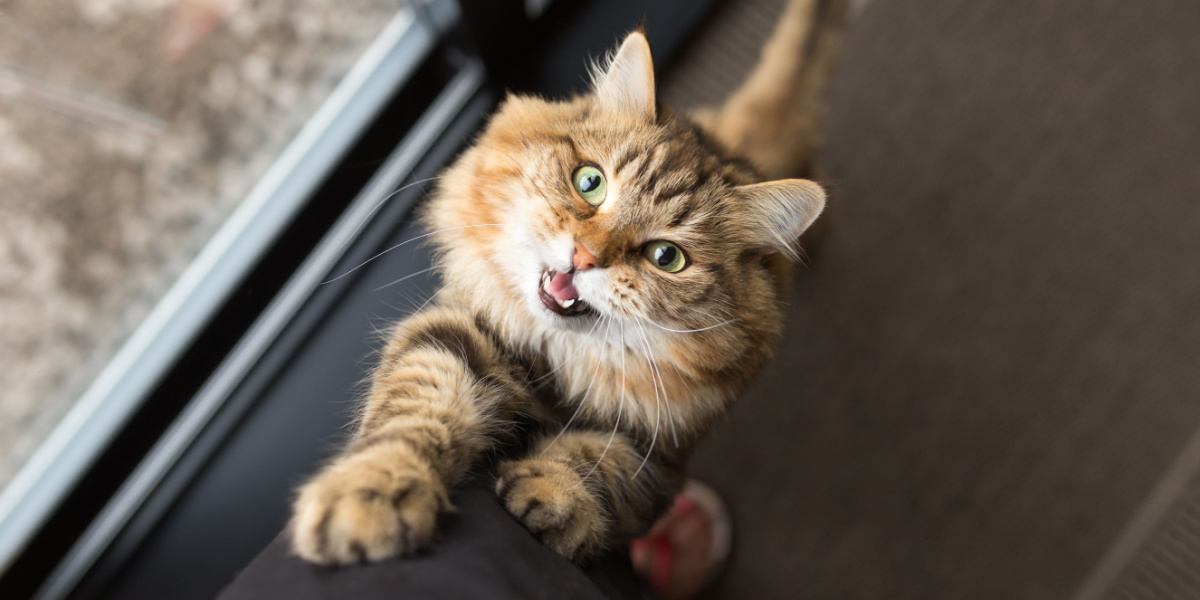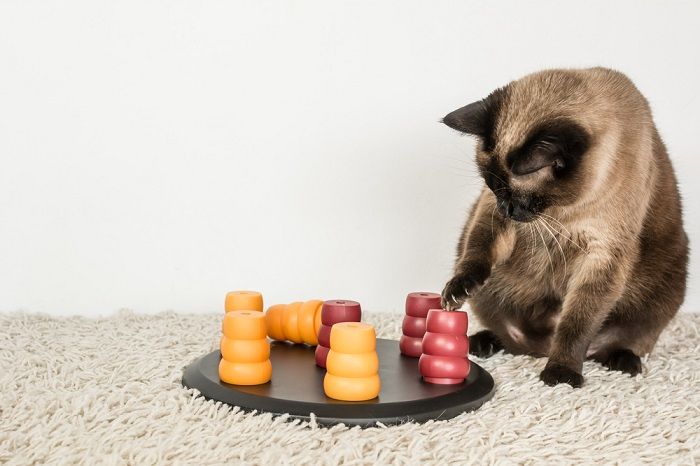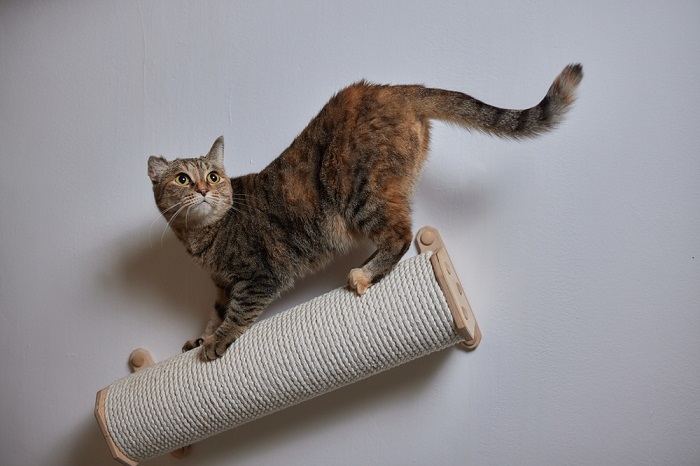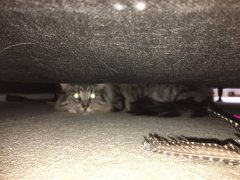
Cats have extremely sharp claws because, before they were domesticated, they needed them for hunting and killing prey, to have extra grip when climbing into trees and branches, and for fighting off other cats that were threats to them. Claws are very useful and effective weapons to have on your body if you’re a cat. However, when you end up on the receiving end of those claws, it’s a very different story.
Key Takeaways
Cats have a strong innate need to scratch and require a suitable object to scratch on.
Cats might use your leg as a scratching post to mark you, as exercise, to get your attention, to sharpen their claws, or just because they're bored.
To stop your cat from scratching your leg, increase play, exercise, and attention, and offer different types of cat scratchers sprinkled with catnip to entice your cat to use them.
Cat scratches can be extremely painful, and if your cat has started to use your leg as a scratching post, you’re probably wondering why. There are many reasons for this scratching behavior and most are very benign. Luckily, you can try a few things to discourage your cat from using you like a scratching post.
Why Do Cats Need Scratching Posts?
Cats are highly motivated to scratch, due to innate instincts. They need something to scratch on as a form of exercise, to sharpen their claws, and to mark their territory. Because indoor cats don’t use their claws for hunting or climbing, scratching posts are a great substitute.
Unless you provide a specific scratching post – or two! – for them, cats are likely to scratch furniture like a sofa or couch, any accessible upholstery like carpets and fabrics, or anything else they can get their paws on. If you don’t want your house ruined by your cat’s claws, a scratching post is necessary.
Why Do Cats Use Legs Like a Scratching Post?
There are lots of reasons your cat might start using your leg as a scratching post. If you don’t have a dedicated scratching post, they might start to use your leg instead. If you bought your feline family member a scratching post and they’re still scratching you, the following might be possible reasons.
1. To Get Attention and Play
You certainly won’t be able to ignore your pet if they dig their claws into your leg. Setting to work on your leg is a foolproof way for your cat to get your attention. They might just be wanting a cuddle or a stroke, but they also might be trying to initiate playtime with you. Scratching at legs tends to reliably get a response from a pet owner, thus reinforcing the behavior to the cat. If your cat feels like they’ve been lacking quality time with you, using your leg as a scratching post might be a final resort.
2. To Sharpen Their Claws
Cats have instincts that tell them to keep their claws sharp for hunting, climbing, and fighting. Although indoor cats no longer need to hunt or fight, your cat still needs to maintain their claws. They need to shed the outer layer of claw that regularly dies off like old skin. Your legs can look like a nice vertical surface to scratch, and will allow them to feel like they’re keeping on top of claw sharpness.
3. To Mark You

Cats use pheromones to communicate messages to themselves and others
Cat’s paws also have scent glands underneath on their pads which release pheromones. Cats use these chemicals to communicate messages and mark their territory. As their owner, they will want to mark you as safe and familiar. This behavior leaves their scent on you and your clothes, so you always smell familiar to your cat, and this helps them feel comfortable in their own home and around you.
4. Because They’re Bored or Stressed
If you’ve noticed your cat’s behavior change and they start to scratch your leg more, this might indicate stress or boredom, especially if you’ve recently had a change in routine or introduced new pet or human members into the family.
5. For Exercise
Cats stretch up and scratch on your leg to help use and tone up their muscles and stretch out their spine, too. Your leg being nice and tall might be seen as the perfect tool for this, especially if you have a very large cat.
Do They Know It Hurts You?
Cats are very sensitive creatures and usually very in tune with their owners. If you react with an “ow!” and pull away when they scratch you, most cats are intelligent enough to know you’re finding it unpleasant and stop.
How To Get Your Cat To Stop Scratching Your Leg
If your cat has started to make a habit out of using your leg as a scratching post, there are a few things you can do to get them to stop.
Remedy Possible Causes

If you think your cat is bored, invest in some new toys and play with your cat for 15 to 30 minutes a day.
First, ensure you have provided plenty of opportunities for your cat to scratch on an appropriate surface. Some cats like vertical scratch posts, others prefer a horizontal surface. Scratching posts should be positioned in visible, high-traffic areas of the home. Ideally, provide a few suitable options.
Make sure you rule out boredom by initiating frequent play sessions with your cat (especially if they’re an indoor cat). You can also buy puzzle feeders and new toys to keep them stimulated for longer. Plenty of attention from you might be all they want, and lots of quality time will mean they’re getting a healthy dose of daily snuggles.
This goes for exercise, too. There are plenty of other ways your cat can use and tone their muscles. Cat trees provide a great way for them to use their muscles effectively indoors and to also encourage behaviors they’d use in the wild. If your cat goes outside, they might like to try to climb up fence posts and real trees, too.
If your cat is using your leg as a scratching post as a reaction to stress, try to identify any causes of potential stress first and minimize them as much as possible. If this doesn’t help at all, you can use pheromone sprays such as Feliway. These plug into your wall and release natural stress-relieving pheromones that relax cats when they smell the odor.
If your cat is using you to sharpen their claws instead of their own scratching post, it might be that it’s become too old and is not as effective. Buy a new scratching post with plenty of texture to help them sharpen up their claws easily.
Train Them To Stop
If your cat tries to use your leg as a scratching post, react quickly and negatively, making it clear that you find it uncomfortable. Try to redirect them away and if they stop, reward them with praise and even a treat.
Alternatively, take them to the scratching post you want them to use as soon as they start to scratch your leg, and if they start to scratch that instead, then reward them again.
Create a positive environment around the scratching posts by placing catnip on or around them, as well as their favorite toys. They are then more likely to have happy associations with the scratching posts and want to be around them, giving your legs a break.
What To Encourage Your Cat to Scratch Instead

Wall-mounted scratchers offer both climbing and scratching opportunities.
There are lots of different types of scratching posts for cats and it might be useful to try out a different type if your cat doesn’t seem to be using their current post as much as you’d like. Different cats have different preferences.
Wall mountable scratching pads can be purchased and don’t take up very much room if you have a smaller living space. Alternatively, some cats might prefer horizontal scratchers rather than vertical scratching posts.
You can DIY or top up your current cat scratching posts with sisal rope or fabric, which are easily found online.
Final Thoughts
There might more than one reason your cat is using your leg as a scratching post. Once you’ve identified a few possible causes and remedied them, the next thing to do is offer some different types of cat scratchers, then and spray or sprinkle them with catnip, or put your cat’s favorite toys near them so your cat starts scratching those instead of your leg.
Also Read: 10 Signs Your Cat Is Obsessed With You
Frequently Asked Questions
Why does my cat scratch me like a scratching post?
This could be because they're bored, they're marking you, they're trying to get your attention, or they don't like their current scratching post and they still want to sharpen their claws.
Why does my cat claw at my pants?
They might be clawing at your pants as a way to get your attention or because they want to sharpen their claws. Cats also like to lay down their scent and they can rub their scent glands (found on on their paw pads), on your pants.
Why does my cat sharpen his claws on me?
This might be because they haven't been given a scratching post or they dislike their current scratching post. Try out a new type of scratcher or spray your current one with catnip to get them to use that instead.







